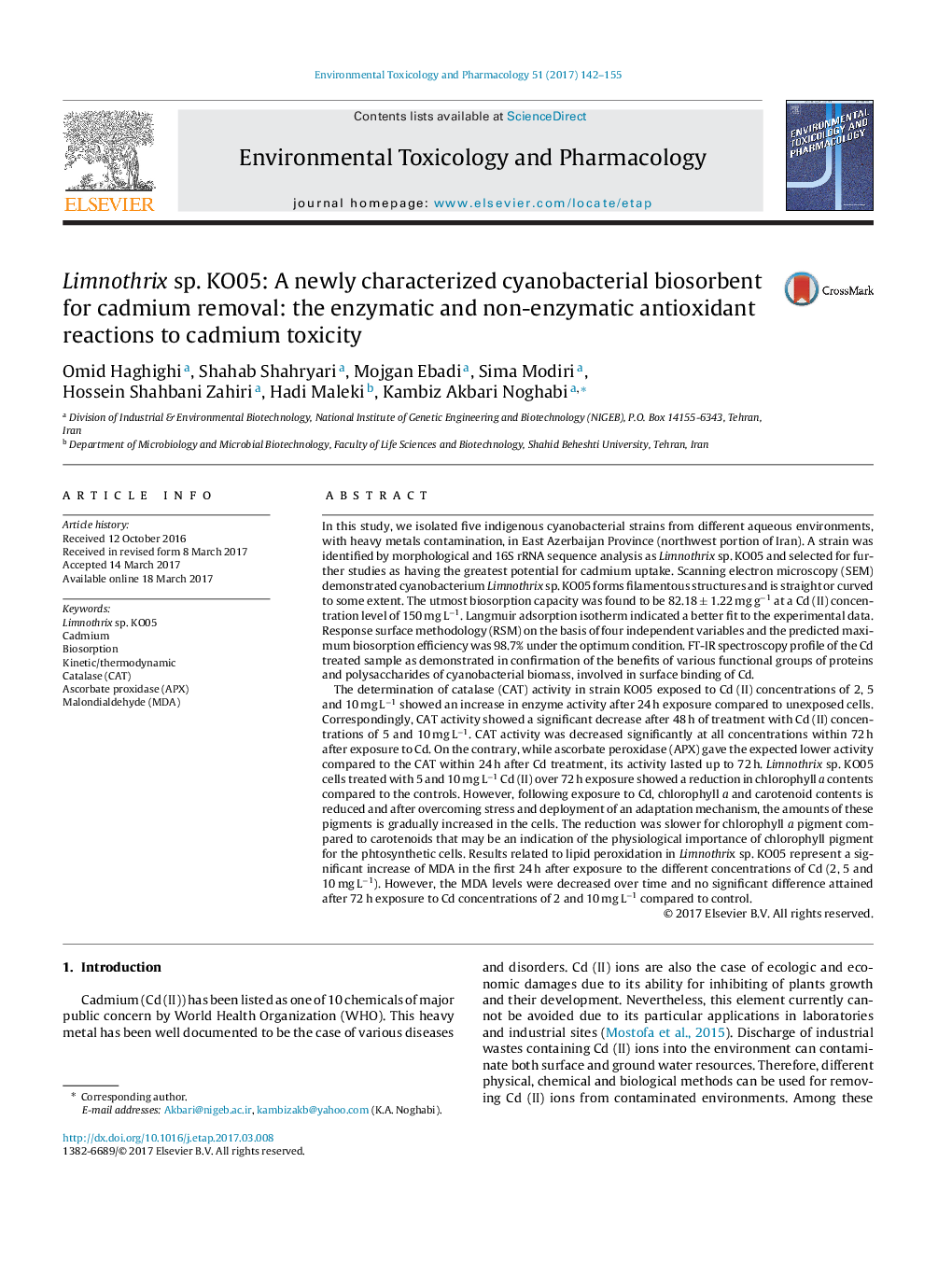| Article ID | Journal | Published Year | Pages | File Type |
|---|---|---|---|---|
| 5559816 | Environmental Toxicology and Pharmacology | 2017 | 14 Pages |
â¢Characterization of a cyanobacterial strain with substantial capability for Cd uptake.â¢Utmost biosorption capacity found to be 82.18 ± 1.22 mg gâ1 at Cd conc. of 150 mg Lâ1.â¢The involvement of functional groups of proteins and polysaccharides in binding of Cd.â¢RSM for parameters optimization of biosorption was 98.7% under the optimum condition.â¢By increasing Cd, phycobiliproteins decreased significantly over a period of 72 h.
In this study, we isolated five indigenous cyanobacterial strains from different aqueous environments, with heavy metals contamination, in East Azerbaijan Province (northwest portion of Iran). A strain was identified by morphological and 16S rRNA sequence analysis as Limnothrix sp. KO05 and selected for further studies as having the greatest potential for cadmium uptake. Scanning electron microscopy (SEM) demonstrated cyanobacterium Limnothrix sp. KO05 forms filamentous structures and is straight or curved to some extent. The utmost biosorption capacity was found to be 82.18 ± 1.22 mg gâ1 at a Cd (II) concentration level of 150 mg Lâ1. Langmuir adsorption isotherm indicated a better fit to the experimental data. Response surface methodology (RSM) on the basis of four independent variables and the predicted maximum biosorption efficiency was 98.7% under the optimum condition. FT-IR spectroscopy profile of the Cd treated sample as demonstrated in confirmation of the benefits of various functional groups of proteins and polysaccharides of cyanobacterial biomass, involved in surface binding of Cd.The determination of catalase (CAT) activity in strain KO05 exposed to Cd (II) concentrations of 2, 5 and 10 mg Lâ1 showed an increase in enzyme activity after 24 h exposure compared to unexposed cells. Correspondingly, CAT activity showed a significant decrease after 48 h of treatment with Cd (II) concentrations of 5 and 10 mg Lâ1. CAT activity was decreased significantly at all concentrations within 72 h after exposure to Cd. On the contrary, while ascorbate peroxidase (APX) gave the expected lower activity compared to the CAT within 24 h after Cd treatment, its activity lasted up to 72 h. Limnothrix sp. KO05 cells treated with 5 and 10 mg Lâ1 Cd (II) over 72 h exposure showed a reduction in chlorophyll a contents compared to the controls. However, following exposure to Cd, chlorophyll a and carotenoid contents is reduced and after overcoming stress and deployment of an adaptation mechanism, the amounts of these pigments is gradually increased in the cells. The reduction was slower for chlorophyll a pigment compared to carotenoids that may be an indication of the physiological importance of chlorophyll pigment for the phtosynthetic cells. Results related to lipid peroxidation in Limnothrix sp. KO05 represent a significant increase of MDA in the first 24 h after exposure to the different concentrations of Cd (2, 5 and 10 mg Lâ1). However, the MDA levels were decreased over time and no significant difference attained after 72 h exposure to Cd concentrations of 2 and 10 mg Lâ1 compared to control.
Graphical abstractDownload high-res image (102KB)Download full-size image
